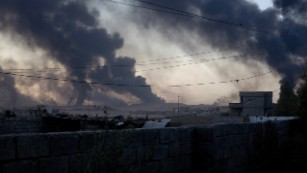First on CNN: ISIS suspected of mustard attack against US and Iraqi troops
Washington (CNN)ISIS is suspected of firing a shell with mustard agent that landed at the Qayarrah air base in Iraq Tuesday where US and Iraqi troops are operating, according to several US officials.
The shell was categorized by officials as either a rocket or artillery shell. After it landed on the base, just south of Mosul, US troops tested it and received an initial reading for a chemical agent they believe is mustard.No US troops were hurt or have displayed symptoms of exposure to mustard agent.One official said the agent had “low purity” and was “poorly weaponized.” A second official called it “ineffective.”A US defense official said troops had gone out to look at the ordnance after it landed. Based on seeing what they thought was a suspect substance, two field tests were conducted.The first test was positive and the second was negative, the official said. The substance is now being sent to a lab for further examination.US troops involved in the incident went through decontamination showers as a precaution. No troops have shown any symptoms of exposure, such as skin blistering. CNN has reported on previous instances where ISIS has fired rounds with mustard agents in Iraq and Syria.The officials said they “had expected” that ISIS might try use chemical weapons as US and Iraqi forces push towards Mosul in an effort to take the city back from ISIS. Several hundred US troops are using the base as a staging area for supporting Iraqi forces.All of this has led the Pentagon to assess on a preliminary basis that it was ISIS that fired at the base, since the terror group has been making mustard agent for some time.In the course of its air campaign against ISIS, US airstrikes have hit several locations the US believes are production sites for mustard agent.US officials emphasized that mustard agent is relatively easy to produce, and they continue to hit suspected manufacturing sites when they find them. US troops are routinely outfitted with protective gear in the event of a chemical weapons attack.(IraqiNews.com) Nineveh – The Qayyarah air base, which the Iraqi forces hoped to use as a staging area to take Mosul back from ISIS, was almost completely destroyed by the retreating ISIS militants, raising new doubts over whether the long-awaited operation will begin this year or not.
Iraqi army commanders stationed at the base said that it will take months of reconstruction before it is ready to receive cargo planes and house the tens of thousands of troops needed for the march on Mosul.
Col. Karim Rodan Salim said, “ISIS began destroying Qayyarah base from the moment they took it over, no less than 95 percent of the base has been destroyed,” adding that, “What we see here was an organized destruction but we were expecting it, ISIS never leaves anything behind.”
“It will take at least six months of rebuilding before the base is ready for the 50,000 troops that will be needed to retake Mosul,” Salim added.
ISIS captured Qayyarah air base in 2014, when it swept across much of northern and western Iraq and drove Iraqi troops out of Mosul.
The coalition hopes to transform the base into a logistics center ahead of the Mosul operation. The Pentagon announced earlier this month that about 400 soldiers from the 101st Airborne Division will deploy to Iraq as part of that effort.
Meanwhile, US commander of coalition land forces in Iraq Major General Gary Volesky said, “The seizure of this base is important because it demonstrates the Iraqi security forces’ ability to maintain momentum as ISIS gets weaker and continues to lose territory.”
ISIS has retreated from areas around Mosul in recent days, including the nearby city of Qayyarah, but it has sabotaged infrastructure on its way out, leaving behind a destruction that in the short-term is hindering further advances by Iraqi forces and in the long-term will require great reconstruction effort.




 There was immediate chatter and concern that there was a functioning terror cell in that does appear to be the case in some form. Rahami did not act alone.
There was immediate chatter and concern that there was a functioning terror cell in that does appear to be the case in some form. Rahami did not act alone.